Soil Sampling Procedure
The primary objective when collecting a soil sample for laboratory analysis is that its composition be representative of the conditions that exist in the field. The general procedure involves the random collection of several individual soil cores over the designated area and combining them to forma a composite sample for analysis. If soil samples are carefully collected and processed, the test result will be very useful. The following guidelines are suggested:
For General Field Sampling
- Identify fields or sampling areas. Typically, fields or sample areas should consist of uniform soils and cropping areas. Record the field identification on the sample bag.
- Use proper sampling tools. A soil probe or auger is best. Use a heavy-weight paper bag or plastic bucket for soil. Do not use metal containers since contamination may result.
- Collect 15 to 20 soil cores at random over the field to provide a single composite sample. Collect separate composite samples for each increment of soil depth that is sampled. Typical soil samples collected are as follows:
- 0-1’ Composite: Generally collected prior to planting field and row crops.
- 0-5’ Profile: Generally collected from perennial crops in one-foot increments.
- 0-3’ Nitrate Profiles: Collected in one-foot increments to a depth of 3 feet for determination of nitrogen sidedress application (row crops).
- Fill out required information on the sample bag completely.
- Deliver samples to the laboratory as soon as possible. Leave the sample bag open to allow for air-drying. Avoid exposure to direct sunlight or heat.
For Problem Solving
-
Collect separate samples from good and poor growth areas. Follow the same general procedures as outlined above.
-
Collect both surfaces (i.e., 1st foot) and subsoil samples. Composite samples for separate analysis.
-
Include a description of the problem. Indicate history and any practices implemented to address the problem.
Soil Sampling and Analysis for Fertility Monitoring
The requirement for soil analysis and the associated collection procedures are dependent upon the crop. Factors such as the soil depth, stage of crop development, and the kind of analysis desired must also be considered. In general, soil samples are collected over the depth where the effective root system exists. Samples collected at deeper depths maybe useful to explain unexpected crop growth or to assess an existing condition.
Soil sampling protocols within the various crop classifications are as follows:
-
Tree crops: A composite soil sample, representative of the field entire root zone, is sampled to a depth of five (5) feet (or to restrictive layer is shallow soil). Samples are collected in one-foot increments and will be initially analyzed for nutrients and salinity. Soil samples are collected in the late winter or early spring.
-
Vine crops: A composite soil sample, representative of the field entire root zone, is sampled to a depth of three (3) feet. Samples are collected in one-foot increments and are analyzed for nutrients and salinity. Soil samples are collected in the late winter or early spring.
-
Field/Row Crops: Soil sample for field and row crops consists of the following:
-
0-1’ Complete: Pre-plant composite soil samples are collected to a depth of 1 foot. Generally, the sample is taken after plowing (or ripping) and disking operations. The sample will receive a complete soil analysis and pre-plant fertilizer recommendations.
-
0-3’ Profile: A composite soil sample representing the first, second, and third foot of depth throughout the field is collected at, or shortly after, crop emergence. The samples will be analyzed for nitrate content and total salinity (ECe). Nitrogen sidedress recommendations may be provided for specific crops as appropriate.
-
Following are examples of soil patterns, soil sampling in common crops and explanations of laboratory results. The explanations of the soil analysis can be used to interpret the results of the laboratory analysis. However, caution should be used in the interpretation of laboratory results. Accurate interpretation of laboratory results requires experience and knowledge, therefore, the use of trained and experienced agronomists is strongly recommended.
Crop Area Model
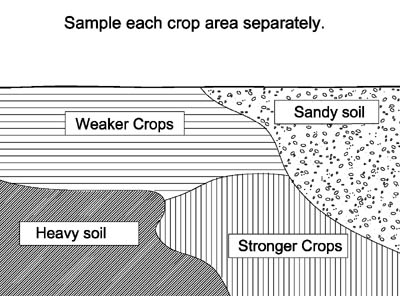
Drip Model
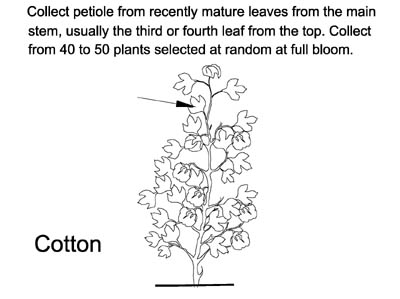
Flood Model
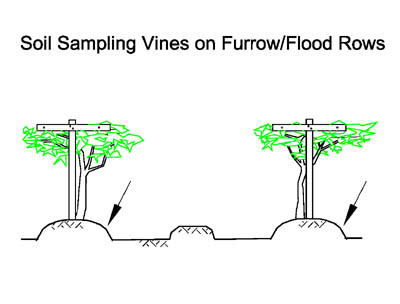
Row Crop Model
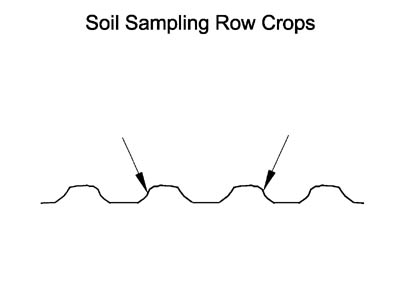
Tree Model

Patterns Model
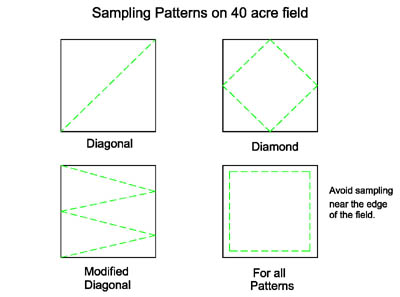
Explanation of Soil Analysis
-
pH – The pH expresses the acidity or alkalinity of the soil. A satisfactory range for most crops is 6.0 to 7.5. A pH above 8.0 indicates a probable sodium problem.
-
ECe – The soil salinity is expressed as the electrical conductivity of a water saturation extract (ECe). The ECe is useful to evaluate changes in soil salinity and the suitability of a soil for crop growth as follows:
| ECe | Crop Responses |
|---|---|
| <2 | Little or no salinity problems |
| 2-4 | Restricts growth of more sensitive crops |
| 4-8 | Restricts growth of many crops |
| 8-16 | Only tolerant crops yield satisfactorily |
| >16 | Few tolerant crops yield satisfactorily |
-
B – Boron is essential in small amounts for crop growth, but it is toxic at higher levels. General guidelines for crop growth are as follows:
| PPM | Crop Responses |
|---|---|
| < 1.0 | Satisfactory for most crop growth |
| 1.0-4.0 | Satisfactory for moderate to tolerant crops |
| > 4.0 | Acceptable only for most tolerant crops |
-
Ca and Mg – Calcium and magnesium levels are primarily affected by soil type, drainage, and cultural practices. Concentrations of both ions increase with increasing soil pH. Calcium deficiencies are rare when soil pH is adequate. Magnesium deficiencies commonly occur in sandy, low organic soils.
-
Na – Sodium is usually considered in relation to Ca and Mg (see SAR) for its affect on soil condition. Relatively high levels of Na generally cause problems with soil water infiltration and plant growth.
-
SAR – The sodium adsorption ratio is a measure of the amount of sodium on the soil exchange complex relative to calcium and magnesium. It may be used to evaluate soil conditions as follows:
| SAR | Expected Result |
|---|---|
| < 9 | Generally no water infiltration problems |
| 9-13 | Increasing water infiltration problems |
| > 13 | Water infiltration problems in all soils |
-
Gyp – The amount of gypsum (tons per acre) required to help correct a soil water infiltration problem due to excess sodium. This value is estimated and reported when the soil SAR value exceeds 9.0.
-
NO3-N – Soil nitrated expressed as nitrate nitrogen (NO3-N). Multiply this value by 4 to get pounds per acre of available nitrogen. Consult an agronomist for interpretation of this value pertaining to crop N requirements.
-
PO4-P – Available soil phosphorus. Consult an agronomist for interpretation of this value pertaining to crop P requirements.
-
K – Available soil potassium. Generally values in excess of 120 to 150 ppm are adequate for most crops. Consult an agronomist for interpretation of this value pertaining to crop K requirements.
-
Zn – Available soil zinc. Generally values in excess of 0.5 to 4 ppm are adequate for most crops. Consult an agronomist for interpretation of this value pertaining to crop Zn requirements.
-
Cu – Copper levels between 1.2 and 1.8 ppm are usually sufficient for crop growth. Factors contributing to copper deficiency include: soil pH above 7.0, high organic matter, and soils receiving high rates of nitrogen, phosphorus, or zinc. Soil applications are usually effective for several years. Foliar applications are also effective.
-
Mn – Optimum test levels of manganese typically range between 14 and 22 ppm. Manganese quickly becomes insoluble when added to soil. Applications should be banded or consist of foliar treatments.